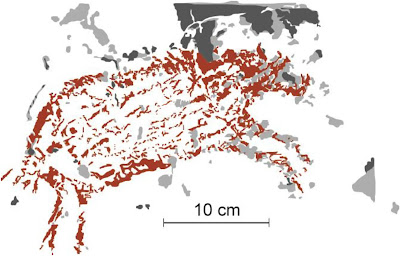On December 6, 2014, I posted a column titled “SPEECH SCROLLS IN ROCK ART?” In this I likened a petroglyph in Chaco Canyon along the trail to Peñasco Blanco trail to the wind or speech scroll of Mesoamerica. In this column I wrote “A familiar convention in Mesoamerican art is the speech scroll, a curved line or shape in front of the mouth used to indicate that the possessor is speaking. We do know that the rock art creating peoples of Mesoamerica, including Aztec, Maya, and Zapotec, all had symbols to represent speech or sound.” (Faris 2014)
I continued “Examples exist in stone sculpture, on painted pottery,
and in the few remaining books that survived the Spanish destruction, the
codexes. We also know that these peoples had influence on the cultures and rock
art of the American southwest. With this in mind I have kept an eye out for the
general shape of a Mesoamerican speech scroll in rock art.” (Faris 2014)
Visiting Chaco Canyon in 1994 I had noticed the distinctive curved shape carved into the cliff while hiking to Peñasco Blanco in Chaco Canyon, New Mexico.
I have now recognized the same symbol in a slide I took at Petroglyph National Monument in September 1988 at Albuquerque, New Mexico. This composition consists of a sort of cartouche; a horizontal rectangle containing a vertical double scroll in the center flanked by four-pointed stars, and a pair of horizontal double scrolls above the rectangle. These double scrolls are nearly identical to the wind symbols recorded by Taube (2001) and also resemble the wind scrolls illustrated emitting from a cave by Pazstory (1998). In conjunction with the four-pointed stars this would seem to reinforce the possibility that the double scrolls are meant to be seen in a sky context, i.e., the wind. However, there is always the possibility that these are meant to refer to speech scrolls as I mentioned in my 2014 posting.
Olmec speech scroll, Karl Taube, 2001, Figure 75, page 107.
For the ancient Olmec “the double spiral represents the dynamic combination of clouds and swirling wind.” (Taube 2001:107)
Another possibility for this double scroll, based upon Aztec imagery, would be as a representation of smoke, another sky symbol. “The speech – indeed the breath – of Mexica deities was connected in mythical terms to the creation of the earth and sky. Parallel to this idea, smoke for the Aztecs was believed to be divine breath, and the glyph that scribes used to depict smoke was volute-shaped, very similar to speech scrolls.” (Mursell) This is, of course, virtually identical with North American First Peoples beliefs that the smoke of tobacco, sage, or other significant herbs, could carry thoughts and prayers to the gods. If this were the case, then this symbol engraved upon the rock might represent a permanent prayer or supplication.
NOTE: Some images in this posting were retrieved from the internet with a search for public domain photographs. If any of these images are not intended to be public domain, I apologize, and will happily provide the picture credits if the owner will contact me with them. For further information on these reports you should read the original reports at the sites listed below.
REFERENCES:
Faris, Peter, 2014, Speech Scrolls in Rock Art?, 6 December 2014, https://rockartblog.blogspot.com/search/label/speech%20scroll
Mursell, Ian, Is There a Name for the Aztec Speech Glyph?, , https://www.mexicolore.co.uk/aztecs/ask-us/is-there-a-name-for-speech-glyph, Internet reference accessed 17 June 2021.
Pasztory, Esther, 1998, Pre-Columbian Art, Cambridge University Press, Cambridge.
Taube, Karl,
2001, The Breath of Life: the Symbolism of Wind in Mesoamerica and the American
Southwest, pages 102-123, The Road to Aztlan: Art From a Mythic Homeland,
edited by Fields, Virginia M., and Victor Zamudio-Taylor, Los Angeles County
Museum of Art, Los Angeles.

















